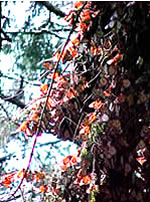
 Centrally
located in the state is the still-active volcano Paricutín.
One of the world’s youngest volcanoes, Paricutín erupted
in 1943 and was heavily active until 1952, when its elevation rose
to 8,448 feet (2,575 m). Over that decade, the volcano created a 10-square-mile
lava field that buried two villages and displaced some 4,000 people.
The church tower of San Juan (above) still stands proudly above the
lava, making a unique sight. Travelers can visit the crater rim and
view the lunar landscape by taking a two-mile hike or hiring a guide
and horse. Centrally
located in the state is the still-active volcano Paricutín.
One of the world’s youngest volcanoes, Paricutín erupted
in 1943 and was heavily active until 1952, when its elevation rose
to 8,448 feet (2,575 m). Over that decade, the volcano created a 10-square-mile
lava field that buried two villages and displaced some 4,000 people.
The church tower of San Juan (above) still stands proudly above the
lava, making a unique sight. Travelers can visit the crater rim and
view the lunar landscape by taking a two-mile hike or hiring a guide
and horse.  The
city of Uruapan is a good base to explore Paricutín,
as well as offering its own riches. The small Parque Nacional Eduardo
Ruiz is a lovely tropical park with lush vegetated banks, waterfalls
and fountains. The water features complement the multiple trails for
hiking and mountain biking, while bird watchers can expect to find
some 130 species in the park. The
city of Uruapan is a good base to explore Paricutín,
as well as offering its own riches. The small Parque Nacional Eduardo
Ruiz is a lovely tropical park with lush vegetated banks, waterfalls
and fountains. The water features complement the multiple trails for
hiking and mountain biking, while bird watchers can expect to find
some 130 species in the park.Further east, Lake Pátzcuaro offers rare glimpses into village life of the 130,000 Purépecha people, direct descendants of the Tarascans, who emerged in the 14th century around the lake. Today, the ruins of a few pyramids and round-based temples are the only visual  reminders
of the Tarascan civilization. Lake Pátzcuaro is well-known
for the Day of the Dead ceremonies that take place, especially around
the island of Janitzio. These impressive ceremonies see boats floating
in the harbor that are covered with candles and flowers, while chanting
people travel from the docks to the island. reminders
of the Tarascan civilization. Lake Pátzcuaro is well-known
for the Day of the Dead ceremonies that take place, especially around
the island of Janitzio. These impressive ceremonies see boats floating
in the harbor that are covered with candles and flowers, while chanting
people travel from the docks to the island.Among Michoacán’s greatest natural assets are its five monarch butterfly sanctuaries located along the far eastern border with Mexico state. Two of the sanctuaries are open daily to visitors – El Rosario and the lesser-known Sierra Chincua – from November to March and host more than 100 million of the beautiful butterflies, which will cover the trees. These long-distance migrants spend the winters within the sanctuaries, and then travel to Canada and the northern U.S.  Along
Michoacán’s 250km coastline lie dozens of untouched beaches
that are great for surfing and swimming, and are surrounded by mangroves
that attract birds and wildlife. Playa Maruata is the principal Mexican
beach where black sea turtles lay their eggs. Along
Michoacán’s 250km coastline lie dozens of untouched beaches
that are great for surfing and swimming, and are surrounded by mangroves
that attract birds and wildlife. Playa Maruata is the principal Mexican
beach where black sea turtles lay their eggs.Come learn more about Michoacán and the rest of the undiscovered "Mysteries of Mexico" at the upcoming Expo Aventura y Ecoturismo in Mexico City from June 3-5, 2004. |
||||
 For
more information about Mexico and exhibiting or attending the 2004
Expo Aventura y Ecoturismo: For
more information about Mexico and exhibiting or attending the 2004
Expo Aventura y Ecoturismo:
|
||||
|

